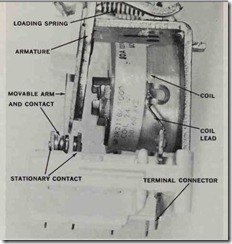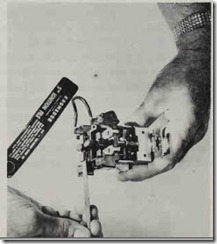What Is The Solenoid
The solenoid is a coil of wire arranged to concentrate the magnetic flux from current flowing through the conductors in the coil. This magnetism can move a linkage or otherwise do mechanical work. Any conductor with current flowing through it has a magnetic field or line of flux surrounding it.
If you coil that conductor many, many times, you concentrate this magnetic force in one small area, and thus form an electromagnet. Add a movable bar, and it’s a solenoid.
How Solenoid Works
Technically, a solenoid is a device for changing electrical energy into mechanical energy, and that’s just what this electromagnetic coil does. It provides the means of causing motion to occur in some component. By arranging the size of a conductor and the size of the coil you build, you can form any number of devices from the simple electromagnetic coil.
It may be designed to lift the plunger in an inlet valve of an icemaker of a refrigerator, or shift the gears in a washer transmission. The solenoid has many applications in home appliances, and in many components you’ll see that it is one of the basic elements which causes a component to function.
Checking A Solenoid
In checking a solenoid, the volt-ohm meter must always indicate continuity or a continuous electrical circuit because there has to be a path for the current to flow through this coil. Unlike the switch and conductor, the solenoid will be classified as a load device since it actually does work and since power is consumed at that point.
Basic Elements Of Solenoid
These three basic elements, the switch, the conductor, and the solenoid, can be combined with each other or with various other ![]() mechanisms to form compound devices. As an example of this, take a switch and attach a solenoid to the movable contact so that when the solenoid is energized, the contact is closed, and when it’s deenergized, a spring pulls the contact open.
mechanisms to form compound devices. As an example of this, take a switch and attach a solenoid to the movable contact so that when the solenoid is energized, the contact is closed, and when it’s deenergized, a spring pulls the contact open.
This is the basis of a simple relay, or contactor, as it is sometimes called. From this description you see that this component has two elements which must be tested— the coil section and the contact (switch) section of the relay.
Applications Of The Solenoid
Relays have many applications in the home. Low-current relays are often used to control a high-current, high-voltage load.
An example of this is the circuitry controlling your central air conditioner, where the thermostat acts as a switch, completing a 24-volt circuit to a coil at the control panel of the system.
When the heavy contacts are closed by the small current flowing through the coil, they complete a 230-volt circuit which starts the compressor and cools the house.
Another application is in a high current load such as in a clothes dryer, where a relay is often used to control the heating element.
The coil of the relay is energized by the timer contacts or by a centrifugal switch in the motor. Since the high current flowing through the circuit to the heating element can cause arcing of the contacts, this load is taken up by the relay rather than by the lighter contacts found within the timer or motor.
Testing The Solenoid Step By Step
This photograph illustrates the major components of a relay. Two separate electrical tests are involved in testing the relay.
-
First, the coil is tested for continuity. The coil on a miniature relay such as this one is composed of thousands of turns of wire no larger in diameter than a human hair. One of the electrical leads from the coil can be seen attached to the right front terminal in the photo. With the test meter set on R x 1000 (the small wire has fairly high resistance) and probes touched to the two coil leads, this section of the relay can be tested.
-
second The contact section is tested like a switch. This relay is closed to one side while open to the other. When it moves to the opposite position as the coil is energized and pulls the armature in by electromagnetic force, the side which is now closed will be open and vice-versa. This is called a single-pole, double-throw switching arrangement (SPDT).
Contact points on this relay are being cleaned with ignition file. Then they will be burnished for temporary repair. While this relay is constructed like that previously illustrated, it is much larger in physical size. Large relays like this, often used for starting large motors like air-conditioner compressors, are often contractors.

